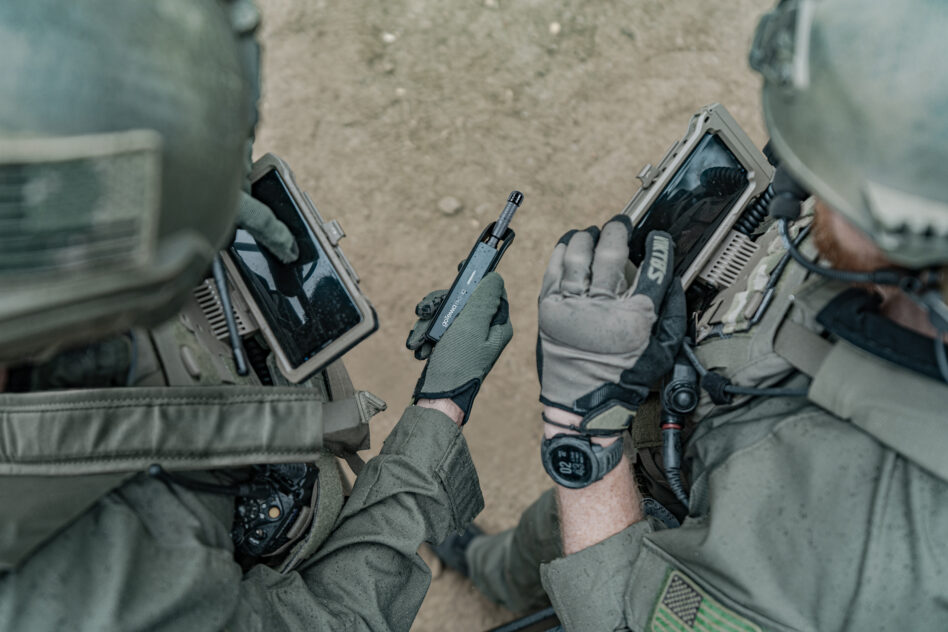Remember when we said it had been a big week for Forterra? Well, it just got bigger.
This morning, the ground autonomy company announced in an exclusive release to Tectonic that they have fully acquired networking and secure comms company goTenna for an undisclosed amount.
“By integrating goTenna technology into our platform, we’re improving user experience in controlling and interacting with robots in operational environments and eliminating communication concerns, especially in denied environments where traditional systems fall short,” Forterra CEO Josh Araujo said in a statement.
Araujo told Tectonic that goTenna will stay fully intact—with former CEO Ari Schuler as President—and become a business line within Forterra. The comms company will also maintain all of its contracts, including with DHS and CBP, and the Air Force.
Money moves, indeed.
Speed networking: Now, you might be sitting there thinking—why in the heck would a ground autonomy company shell out cash for a networking and comms company? Well, that’s because, to quote Araujo, “Self-driving can work great, but if you don’t have comms, you’ve got a brick sitting out there.”
goTenna’s tech basically ensures that warfighters and tech all stay connected, even in the most jammed and contested of environments. Here’s what they build:
- Pro X2 Radio: goTenna’s flagship tactical mesh radio. Ruggedized, low-SWaP, and fully ATAK-integrated. Enables secure position sharing, text, and situational awareness in no-signal or GPS-denied environments. These are designed to be thousands of dollars cheaper than traditional radios.
- Pro X Radio: The previous generation of the radio, still widely deployed by US and allied forces. Has slightly less range and bandwidth than the X2.
- Pro Deployment Kit (PDK / PDK2): Pre-configured field kit containing 20+ Pro X2 radios, charging docks, antennas, and software licenses.
- goTenna Pro App: An Android/ATAK plugin for mapping, chat, and team tracking over mesh.
This all runs on goTenna’s Aspen Grove mesh networking protocol, which “increase[s] resistance and resilience [in] degraded and denied environments,” Schuler told Tectonic.
“If you’re operating in an area that has less bandwidth, maybe because your adversary is jamming you, maybe it’s just not available because you’re extremely off grid, radios and capabilities enhanced by Aspen Grove will do better,” he added.
On contract: As mentioned, goTenna already has a ton of contracts with the DoD and across the government, including:
- A $15M Air Force STRATFI contract for mesh capabilities with the US Air Force
- A $99M IDIQ with US CBP for mesh networking for Border Patrol and other CBP units
They’ve also got relationships with the Navy, and the Army and National Guard have issued a notice of intent to sole-source PDK2 kits from the company. The company says they’ve deployed “tens of thousands” of their X2 radios into the field.
And they’ve got a pretty solid amount of private capital, too. According to Pitchbook data, the company has raised a total of $92M since it was founded in 2013, with participation from investors including 3Spoke Capital, Rsquared, and Litquidity Capital. That gives us a decent sense of what a pretty penny Forterra has paid to improve their comms.
Plug it in: Araujo told Tectonic that they’ll have goTenna comms built onto Forterra’s vehicles within the next few weeks, and full integration and jointly fielded products within the next three months.
Once Forterra’s vehicles are goTenna comms-equipped, teams will be able to maintain links with other humans and the robots they’re controlling, even when an adversary—say, China or Russia—is jamming them. With UGVs plus goTenna radios, Schuler said, “You have this unique ability to go anywhere on the planet, circle a geographic area, and then deploy the right mix of assets, and ensure that the men and women operating in that area have situational awareness.”
“What we bring and augment is the ability to have better contested and denied comms, but also the low price point of our capability means you can broaden the comms to more and more users around the assets, which again leads to higher rates of mission success,” he added.
That means that robots stay linked in, humans stay tracked, and teams stay connected no matter how close to the front line (or behind it) you are. And because goTenna is already plugged into the DoD’s systems—including ATAK—that means Forterra’s kit will now be able to plug and play, too.
BFFs: To start out, Araujo said that the two companies will focus on delivering on their current contracts and introducing their customers—including DoD and DHS—to how their integration expands capabilities. From there, they’ll start rolling out joint capabilities.
“You can simply do more when you start bringing autonomous vehicles in the mix, and you can create better products together,” Schuler said, “So we expect to support all of the same customers as we do every day, but over the next year and onward…we’re going to start rolling out joint products together that get that same ultimate mission goal accomplished.”
Neither Schuler nor Araujo would say what, exactly, they’ve got on their product timeline, but Schuler said we could expect integrated “products on both sides that let you pull together a better situational awareness for the customer.”
Araujo also didn’t rule out future acquisitions to expand Forterra’s capabilities even further.
“Our overall strategy is just to bring a best of breed approach to the customer,” he said, “We’re really agnostic to whether we partner, bring in other partners, build it ourselves, or acquire it.”
But for now, Schuler said that the partnership—comms plus autonomy—gives the US and its allies a serious leg up over adversaries like Russia and China.
“[We now have] this ability that I think very few, if really no one else can do,” Schuler said, “[We can now] project…missions anywhere on the planet, without touching a satellite, without touching a commercial cellular network, in a way that will really give us an advantage over our adversaries.”

